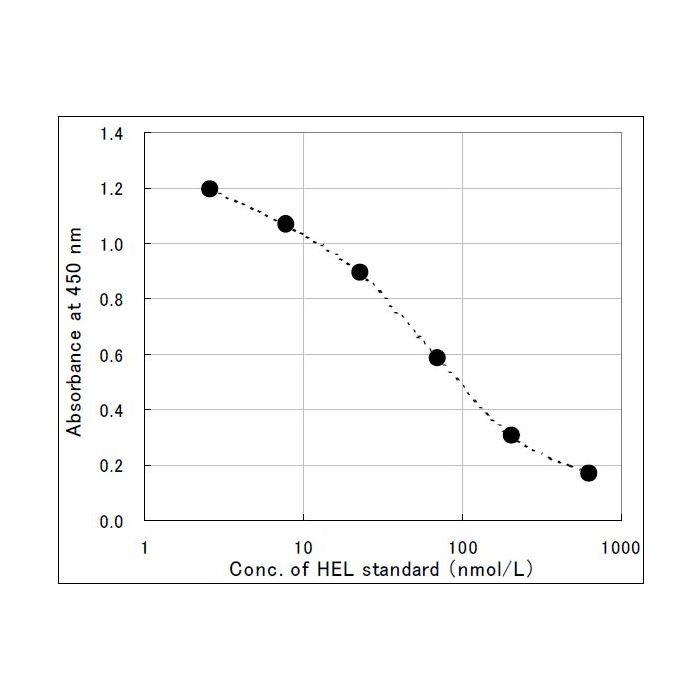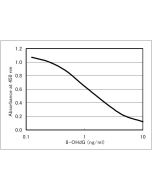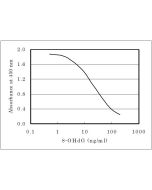Cookie Policy: This site uses cookies to improve your experience. You can find out more about our use of cookies in our Privacy Policy. By continuing to browse this site you agree to our use of cookies.
JaICA
Hexanoyl-Lys [HEL] ELISA Kit

| Product Details | |
|---|---|
| Product Type | Kit |
| Properties | |
| Application Set | Quantitative ELISA |
| Specificity | Specific to N-epsilon-Hexanoyl-Lysine adduct. |
| Crossreactivity |
All Human |
| Quantity | 96 wells |
| Range | 2 - 700 nmol/L |
| Sample Type |
Serum Urine |
| Assay Type | Competitive |
| Detection Type | Colorimetric |
| Other Product Data | This ELISA Kits works also for DNA extracted from cultured cells or tissues. |
| Declaration | Manufactured by JaICA. |
| Shipping and Handling | |
| Shipping | BLUE ICE |
| Short Term Storage | +4°C |
| Long Term Storage | +4°C |
| Handling Advice | Do not freeze. |
| Use/Stability | 12 months after the day of manufacturing. See expiry date on ELISA Kit box. |
| Documents | |
| Manual |
 Download PDF Download PDF |
| Product Specification Sheet | |
| Datasheet |
 Download PDF Download PDF |
Oxidative damage to lipids (lipid peroxidation) has been found to play an important role in various disease and aging processes. During early stages of lipid peroxidation, lipid hydroperoxides (LOOH) are formed. These can react additionally to form later stage end products such as malondialdehyde (MDA) and hydroxynonenal (HNE). LOOH is measured to quantify early stage or acute lipid peroxidation while MDA is commonly measured to quantify late stage or chronic lipid peroxidation. More recently, it has been reported that 13-hydroperoxyoctadecanoic acid (13-HPODE), a precursor to 13-hydroxyoctadecanoic acid (13-HODE) can react with proteins to form measurable adducts by covalently binding to specific amino acid residues. The Hexanoyl-Lysine (HEL) adduct is formed upon oxidative modification of omega-6 fatty acids such as linoleic acid, the predominant polyunsaturated fatty acid (PUFA) in the human diet, and arachidonic acid. HEL may be another useful biomarker for detecting and quantifying the earlier stages of lipid peroxidation.
- Preparation of a monoclonal antibody to N(epsilon)-(Hexanonyl)lysine: application to the evaluation of protective effects of flavonoid supplementation against exercise-induced oxidative stress in rat skeletal muscle: Y. Kato, et al.; BBRC 274, 389 (2000) [Development and characterization of anti HEL monoclonal antibody]
- Possible involvement of oxidative stress in salivary gland of patients with Sjogren's syndrome: K. Ryo, et al.; Pathobiology 73, 252 (2006) [Detection of HEL in saliva samples from patients with Sjogren's syndrome]
- Effect of prophylactically administered edaravone during antegrade cerebral perfusion in a canine model of old cerebral infarction: T. Suzuki, et al.; J. Thorac. Cardiovasc. Surg. 133, 710 (2007) [Detection in canine serum samples]
- Oxidative stress impairs oocyte quality and melatonin protects oocytes from free radical damage and improves fertilization rate: H. Tamura, et al.; J. Pineal. Res. 44, 280 (2008) [Intrafollicular concentration of HEL was significantly reduced by antioxidant treatment]
- Etanercept reduces the oxidative stress marker levels in patients with rheumatoid arthritis: Y. Kageyama, et al.; Rheumatol. Int. 28, 245 (2008) [Reduced urinary HEL levels after initial treatment with etanercept]
- Tear cytokine and ocular surface alterations following brief passive cigarette smoke exposure: V.T. Rummenie, et al.; Cytokine 43, 200 (2008) [Increased HEL concentration in tear by brief passive exposure to cigarette smoke]







